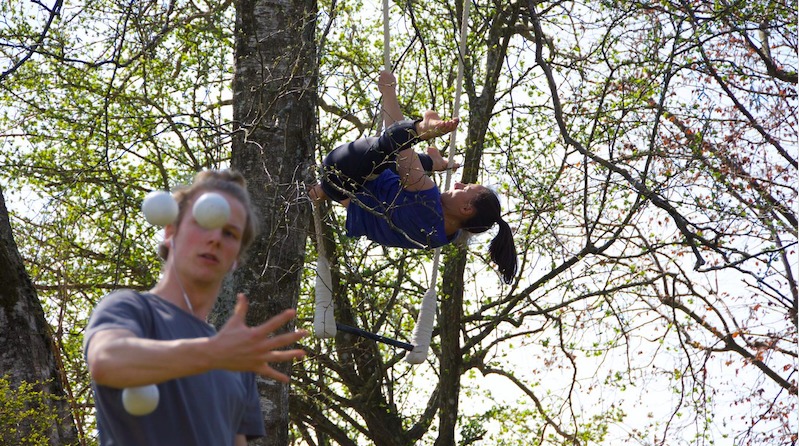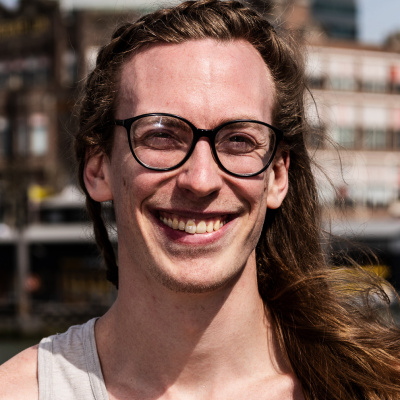Letting Things Be at the Zero Point– Quarantined Circus
As a circus artist based in the Netherlands, these are some of the observations I’ve made during this self-quarantine. They’re not statistically backed up, nor observed through an academic lens. They’re small snapshots of what is going on around me amidst this pandemic that has stalled the economy, our countries and our careers.
The timeline of all performance venues, gyms and social activities closing down is pretty clear in retrospect, and truth be told, it’s also not particularly interesting. What’s interesting is how we handle and adapt to such a big change in our daily lives. I say ‘we’ as a larger circus collective, but since the self-isolation procedures started, I’ve only been in contact with a handful of friends, so what I actually mean is ‘me and some other circus artists in Rotterdam’, and ‘circus friends around the world that I stay in touch with over the internet’.
That social media plays a large part of our day to day lives is nothing new, but the speed of our (‘our’ meaning the friends I follow on Instagram) interactions is what is different. Within the first weeks of self-isolation, I had already gotten more Instagram story-challenges than I can recall having gotten in the past six months, and they just kept coming.
The sheer amount of invitations to “do 10 of these and nominate someone else”, “post embarrassing photos” and “tag names of other artists” made me not want to open the app in the first place, as I very rarely participate in these things anyway. Initially, I just ignored them, but I soon realised that the function is much deeper than infinitely repeating post patterns. In sharing so many of other artists’ posts we’re reminded that we’re not alone. We’re all in this weird, wobbly, boat together, and we’re all dealing with it differently. Since we can’t hang out in the training hall anymore, we have to find other ways of creating a sense of collective. Nothing will replace being on stage together, or long, grueling training hours in each other’s company. Since those things are now put on hold, and we’ll have to make do with training in confined spaces with make-shift equipment, we might as well also encourage each other with whatever tools we have, i.e. social media. It’s not an ideal way of maintaining a spirit of collective, but making the most of a not-ideal situation seems to be the anthem of this quarantine.

Another reason I’m more aware of social media being an important part of day to day life is of course also the amount of time available to us. We’re all having more time on our hands than anyone knows how to handle. As circus artists, the amount of time spent on managing, planning, producing, training and performing can be enormous. When all of these things are taken away by means of months of work canceled and theatres closing down, what do we do with all the time we now have, besides social media?
Home training is of course an option for some, but you can only do so many follow-along yoga videos in a day. My juggling friends seem to find creative ways to deal with smaller spaces and odd props, leading to a plethora of clever juggling material being posted from living rooms, balconies, back gardens and kitchens (Henri Kangas for example.) Not all of us are quite as fortunate as to have a discipline that you can do in a living room though, so apart from social media and home workouts, what do we do?
A friend of mine found that once time isn’t an issue, the distances you can cycle drastically change, and started going on road trips by herself. What started out as an alternative to public transport then escalated to inter-city trips through the countryside. Resulting in her re-discovering her home country, something she said she had not expected at all.
“To avoid lots of people and public transport I chose to bike to be able to see my two best friends in Amsterdam. It started with two times 80 km. After that, I’ve been biking a total of 1460 km in this quarantine time.”
Whilst the first trip was a way to avoid crowds and heavily populated areas, these journeys became more than just a practical solution.
“For me it was like a way to still ‘travel’. Instead of traveling to other countries, I traveled in my own country. It became a way to discover my own country. I’ve discovered how beautiful Holland can be. And that “the Sims” exists in real life too. Sometimes I felt like I was in the Sims and I could just choose any house I saw along the road to live in. I imagined myself in all these big and crazy houses. That took my focus away from my daily thoughts. So you could say it was partly mediation. I could forget about this whole Corona shit and just enjoy the freedom the bike gave to me at that moment.”
Worrying About What’s to Come
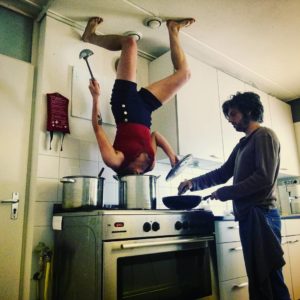
However, we’re not all so fortunate as to have revelatory experiences about where we live. Amongst my friends, there’s also a growing worry about what’s to come after this. There’s no magic wand that’ll turn theatres and festivals back to the way they were. The prospect of walking back into a field that’s starved and under-funded and then trying to rebuild a working field is maybe a harsher reality to face compared to the cancellations we’re currently dealing with?
I reached out to Adrian Berry, who runs the equally illustrious and punk Jackson’s Lane in London. We spoke about how to prepare for a season of performances after a global event such as this, and what habits we might have to acquire to make a sustainable return to performing. What we both agreed on, as performer and artistic director, is the need to restructure, and to let things take time. Instead of trying to plan non-stop shows, there’ll be a larger need for space to create and for artists to both train and make work. Adrian imagines a Jackson’s Lane with an increased focus on using the studio spaces in the venue as artists spaces during the near future, to make sure that there will be work to showcase not just once theatres re-open, but also for the years to follow since it’s not just performances that have had to cancel, but also residency spaces.
The general idea, he says, is to, at first, do less of everything, while also doing it better.
The general idea, he says, is to, at first, do less of everything, while also doing it better. The circus field is something that we’ll have to build back up step by step, testing the boundaries of what’s available little by little, and by doing this avoiding the inherent risks of jumping headfirst into an economical unknown within a field that’s already a pretty unstable one.
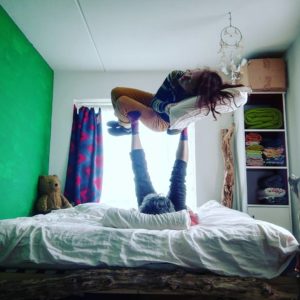
While speculating about how shows might have to look for a while, Sweden pops up in the discussion. Controversially, but within government restrictions, a music venue in Sweden is still playing shows. The independent venue Plan B has a long-standing history of carving their own path, and during these times they’re true to that. The venue has booked artists still happy to play and is restricting the audience to 40, to fit the band and venue staff all within the current national restriction of no crowds larger than 50.
Whilst this is currently maybe only possible in Sweden (who has notoriously relaxed measures against the ongoing pandemic) it’s possibly a hint towards what shows can look like in the near future of cautiously reopening theatres. Tightly restricted venue capacities spaced seating and a season focussing on local artists to avoid the risk of travelling complications might all be a very real future. Rather than imagining a swift return to packed festivals and theatres, these are the options we have to discuss. How can we gradually reinvent a performing arts scene? What are the key points in not just putting shows back on stage, but building for sustainability?
Speaking of sustainability, I shared (digital) coffee with the always inspiring Marie-Andree Robitaille, and we discussed responsibilities, accountability and how our practice reflects our dependence on market structures.
If circus is a beautiful unicorn in an otherwise grey landscape of capitalism, why do shows start and stop with the rest of the economy?
Of course, everyone has a longing for the ‘normal’ of ancient times in January, but an event like this is a once in a lifetime opportunity to really take a step back from the habits we depend on. Whilst we might often think that circus stands apart from ‘normal’ businesses, the realisation that we depend on the exact same structures as them should give us a clue as to how untrue that is. Is circus truly as democratic as I’d like it to be if it depends on cheap airline travel, large scale PR campaigns and packed theatres? If circus is a beautiful unicorn in an otherwise grey landscape of capitalism, why do shows start and stop with the rest of the economy? What better time to reflect on how we as artists are consumed, and what we give back to the system that consumes us, than now?
“Living a pandemic and surviving it requires new strategies and circus is no exception,” says Marie-Andree over coffee.
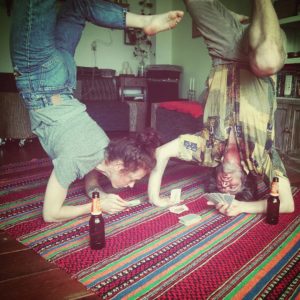
Taking this surprise intermezzo as a way to consider our practices is perhaps the ultimate way to make the most of the situation. Whilst social media is flooding with ‘let’s make the most of a bad situation’-idioms, my talk with Adrian and Marie-Andree made me consider, perhaps, the ultimate stance is positive thinking.
Optimism is of course in short supply at the moment, considering that at the time of writing this the global pandemic we are in is claiming thousands of lives every day. However, that should be the tragedy here, not how business isn’t going on as usual. Let’s mourn the people we couldn’t save, not the economy, and turn our attention to things we can change and improve.
Let’s not think of this as a bad situation because a halted market stumps our cash flow, but let’s instead approach this as a new working situation, and adapt our methods to it. Let’s find new ways to disseminate and share work, and now that we are confined to work within our local spheres, maybe the result will be a more homegrown and sustainable scene? Who would our audiences be? Where is our stage? What are the tools we have in our most immediate area?
“Let’s take a pause instead, let’s be quiet, let’s be invisible… Let things be at the zero point…In suspension before we are forced into landing… Let’s take the time of not doing… so that we can maybe open up for new possibilities. Slow and not doing as a strategy to open up for new possible realities…” says Marie-Andree.
I imagine two different approaches here. On one hand, we can sit tight, do our home workouts, and wait for borders to open, festivals to reschedule and for the market to catch back up. The other option is to accept that this might just be how life will look for a while, and start working with that as the ground zero for new practices. Circus has in its relatively short lifespan had many reformations, and this might be another one. We can look at the tools we have at hand right now, not as limited or constricted, but as a means to finding a more sustainable practice. When I say sustainable, I don’t mean that as in ‘travelling more ecologically’ but rather not depending on travel at all.
In my chat with Marie-Andree, the topic of democratising circus came up, and whilst untangling that topic is a conversation best left for another day (and another pot of coffee), I think we have more tools at our disposal right now than we might realise, and it’s up to all of us to independently look at our own practice now that we’ve been given this unprecedented chance for space and time to reflect.
As with most things in life, we’re not given an option to choose whether we want to deal with this situation or not. All we can choose is how to manage our expectations and outlook. Optimism is the cheapest luxury we can offer ourselves right now, but it will have to be mixed with a healthy pinch of grit too. Hopefully, this experience will be a learning tool for all of us and will equip us with new skills and perspectives that’ll come in handy in the future, especially since there wasn’t much ‘normal’ about the circus field in the first place, and there certainly won’t be much normal to go back to once the restrictions are gradually lifted.
Feature photo Raf Pringuet. All others photos courtesy of Fabuloka CircusTheater...
Do you have a story to share? Submit your news story, article or press release.

